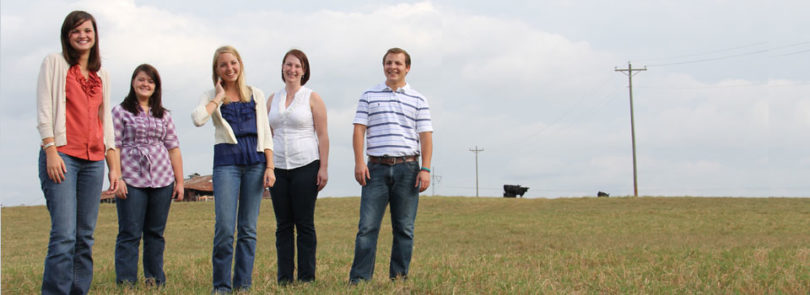In college time, four years can stretch on forever. It’s long enough to switch majors multiple times, drop several classes, fail a course, drink gallons of caffeine, study abroad, add an extra year and work a few jobs.
Five first-year veterinary students have done very few of those things. They didn’t switch majors. They didn’t fail courses. They didn’t drop classes — they made it through in four years.
They are the students who wear cowboy boots to class, toss hay during the summer, get sunburnt helping out on their family farms and, instead of worrying about whether they were going to get into veterinary school after graduation, spent their time waiting for the first day of classes at the UGA College of Veterinary Medicine.
Deana Veal, Jennifer Dalton, Katie Rosenbalm, Shannon Larsen and Zeb Duvall kicked off the Food Animal Veterinary Incentive Program (FAVIP) in 2007, and now they’re reaping the rewards of their work—one lecture and necropsy lab at a time.
Innovative program
The first class of the Food Animal Veterinary Incentive Program was several years in the making before five students signed on and made it a reality.
“It took a couple of years because it is a true collaboration,” said Paige Carmichael, the CVM’s associate dean for academic affairs. “UGA and the College of Veterinary Medicine have never set aside five seats for any other program except this one.”
FAVIP is a unique partnership between the CVM and the UGA College of Agricultural and Environmental Sciences (CAES). Students who are chosen for the program major in animal science, avian biology, dairy science or poultry science as undergraduates. Then they must complete at least 300 hours of veterinary internships and score well on the Graduate Record Exam (GRE). In veterinary school, they commit to one of three tracks: food animal, mixed animal or population health.
“The plan we put together was structured as such to make sure the students were exceptional,” said Carmichael.
“We did a very nice job of selecting them, and they did a nice job of getting through the program,” said Dean Pringle, an associate professor in CAES who oversees the undergraduate side of the FAVIP program.
When it comes to veterinary school, every advantage helps. There are only 28 colleges of veterinary medicine in the United States. On top of that, about 560 students apply annually to the 102 spots available in the UGA CVM program.
Having a guaranteed spot—after meeting all of the requirements—can make the difference between a summer spent nervous about the first day of class or searching for a different future.
“At CAES, they gain the experiences to ground them in food animal medicine,” said Carmichael. “They gain a true understanding and are assured of a clear path to acceptance. The students have done everything we ever asked of them and more.”
The need
Jennifer Dalton grew up in rural Banks County, where she showed livestock through Future Farmers of America and 4-H. To the southeast, the county is bordered by Interstate 85 and challenged by traffic constantly flowing in and out of Atlanta. But even a county close to a metro area can still be vet-less.
“I grew up around large animals and sheep and hogs,” she said. “What I want to do is go back and set up a vet office in Banks County. Right now, you have to go to Royston in Franklin County.”
Banks County isn’t the only one that’s hurting. “Certain counties in Georgia have no veterinarian to provide large animal services,” said Dr. Sheila Allen, dean of the CVM.
These include Marian, Stewart, Webster, Chattahoochee, Emanuel, Candler, Jenkins, Burke, Treutlen, Upson, Crawford, Peach, Meriwether, Pike, Coffee, Jeff Davis, Bacon, Berrien, Irvin, Atkinson, Clinch, Wilcox, Crisp, Telfair, Wheeler, Early, Baker and Miller counties, according to the USDA.
The top needs are for veterinarians who practice beef cattle, dairy cattle, swine and small ruminant medicine. Other shortages include needs for veterinarians in food safety, public health and epidemiology.
“Being a veterinarian is not only about keeping the animal healthy, but providing a safe food supply,” said Dr. Allen. “Having enough veterinarians is critical for public health. We have a shortage of boots on the ground — people in diagnostic labs, at slaughterhouses making sure people are following humane and sanitary practices, and then in food inspection.”
In 2006, the year before FAVIP started, not a single UGA veterinary student went exclusively into large animal medicine. This fall there are 17, up from eight in 2010, none in 2009 and one in 2008. Part of the reason is finances. With loans topping $110,000, students look for the highest-paying jobs. These are usually found in small animal practices—and in people medicine.
“Right now, there are about 80,000 practicing vets,” said Carmichael. “It’s a small and close-knit group. That itself enhances the experience. In comparison, there are about 800,000 medical doctors.”
As more veterinarians retire, the need becomes greater in both small and large animal practice. But the real deficit is in high-need areas. To attract students to these areas, Georgia Gov. Nathan Deal signed House Bill 60 in June 2011. For every year recent graduates work in an area of documented need, the State Veterinary Education Board will purchase $20,000 of their debt—up to $80,000. While the Bill itself has passed, appropriation of funding is anticipated in the future.
The USDA also runs a veterinary medicine loan repayment program, which pays $25,000 per year and comes with a three-year commitment for veterinarians who serve in shortage areas.
“Some rural counties don’t have a veterinarian at all,” said Carmichael. “It’s not always as feasible for students to pursue that career path. We wanted to help meet the need.”
From seniors to first-years
CAES’s Dean Pringle spent four years teaching and mentoring his students. He saw them grow from freshmen to “leaders in our department and our college,” he said. “The next class is the same way. These kids are a lot more than food animal students. They’re leaders, and I think they’re going to offer a lot and have a very positive effect on those students who didn’t have that food animal experience.”
“About 80 percent of veterinarians view our profession as more than just a job,” said Carmichael. She’s wanted to be a veterinarian since she was 8 years old. “It’s a calling, and we wanted to tap into the calling we knew was there. You want to tap into that love before other interests get in the way.”
Right now, Larsen, Veal, Duvall, Rosenbalm and Dalton are squinting to see straight after hours of studying, necropsy labs and lectures, but thanks to the undergraduate requirements for FAVIP, they have a practical advantage over many of their classmates.
“Undergrad went by really fast, but at the same time, it got me excited about vet school,” said Larsen. “It made me even more sure.”
Squirrels to cattle
Deana Veal can’t remember a time when she didn’t want to be a veterinarian. She grew up showing hogs in 4-H and cows through FFA. And on her family’s Wrightsville farm in southeast Georgia, she was “always involved with birthing calves,” she said. “Now I own a small herd. They’re my cows, and I make the breeding decisions.”
Veal’s love for animals started on the farm—and continued in a veterinarian’s office in Sandersville, where Dr. Sam Evans gave her a chance to continue her informal education.
“The day I turned 16, I started volunteering,” she said. “I helped with dogs and cats. One day I may be going on a call with horses. The next day I would be filing in the office.”
Evans also gave her a push toward formal education.
“He introduced me to FAVIP,” said Veal. “I was a junior in high school. He got me in touch with the right people. At the beginning of my freshman year, my thoughts were ‘eight years, here we go.'”
When she graduates, Veal wants to end up “somewhere like Wrightsville,” she said. “I want to be a veterinarian to all sorts, from squirrels to whole herds of cattle, where every day is different.”
Perdue scholarship
A new scholarship honoring former Georgia Gov. Sonny Perdue has been endowed to support students in the Food Animal Veterinary Incentive Program. The Governor Sonny Perdue Scholarship Endowment Fund was created by friends of the former governor—primarily by his former agricultural liaison Donnie Smith—to help relieve the shortage of food animal veterinarians in Georgia
FAVIP students may apply to be a Perdue Scholar during their junior or senior year of undergraduate study or during any year of their veterinary degree study.
The FAVIP is a joint effort between the UGA College of Agricultural and Environmental Sciences and the UGA College of Veterinary Medicine. The goal is to recruit and train future veterinarians in food animal medicine and rural practice for underserved communities.
Perdue was the 81st governor elected to Georgia’s top post and held office from January 2003 through mid-January 2011. He graduated from the UGA College of Veterinary Medicine in 1971 and worked as a veterinarian and agribusinessman prior to his election to the Georgia Senate in 1990.
During his tenure, Perdue was instrumental in helping the CVM secure funds to design the Veterinary Medical Learning Center. The funding, which was approved by the Georgia General Assembly in 2010 and made available to the college that fall, provided money to complete the construction drawings for the new teaching hospital.
Editor’s note: Some content in this feature appeared in the Fall 2011 issue of the College of Agricultural and Environmental Sciences’ magazine Southscapes.






